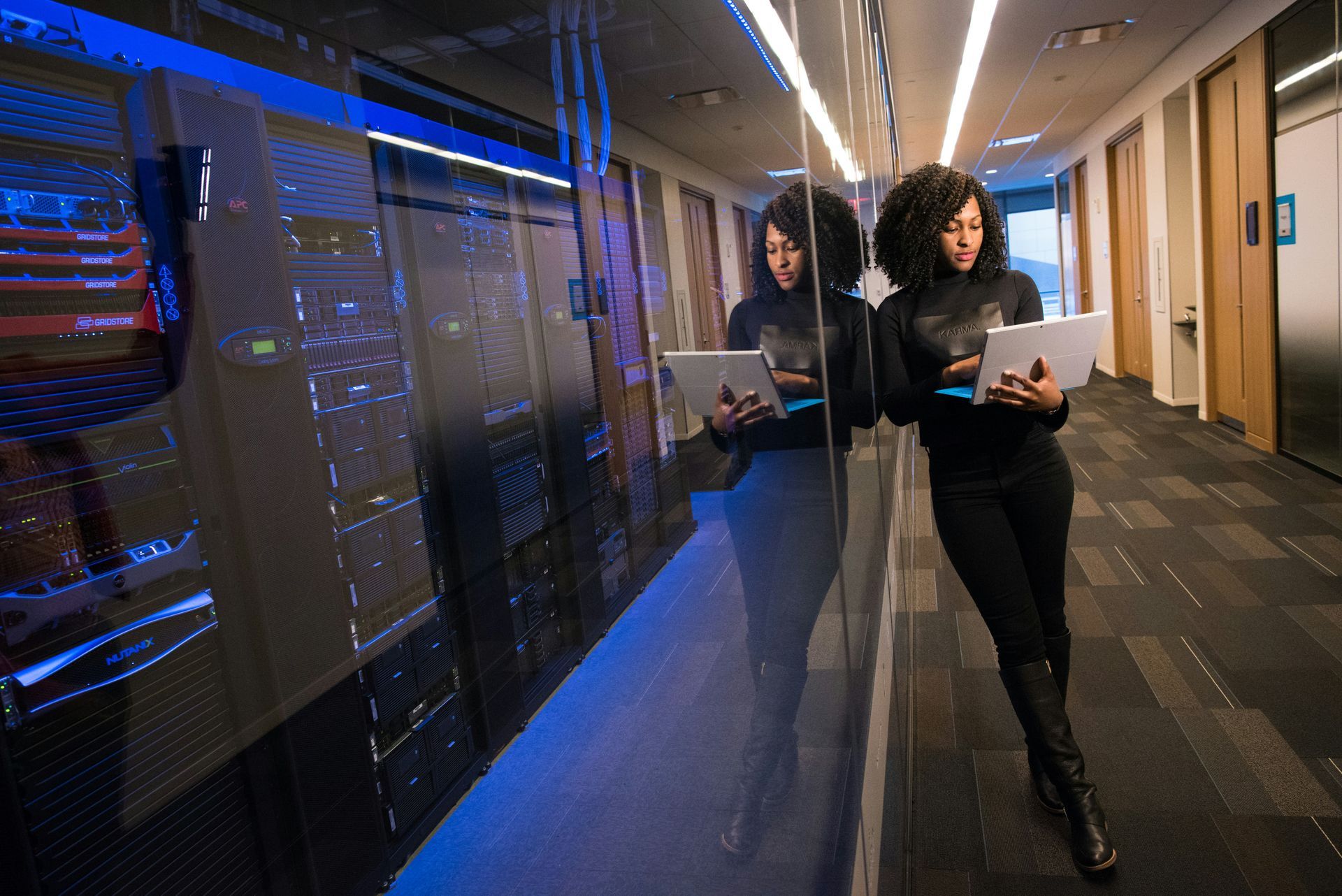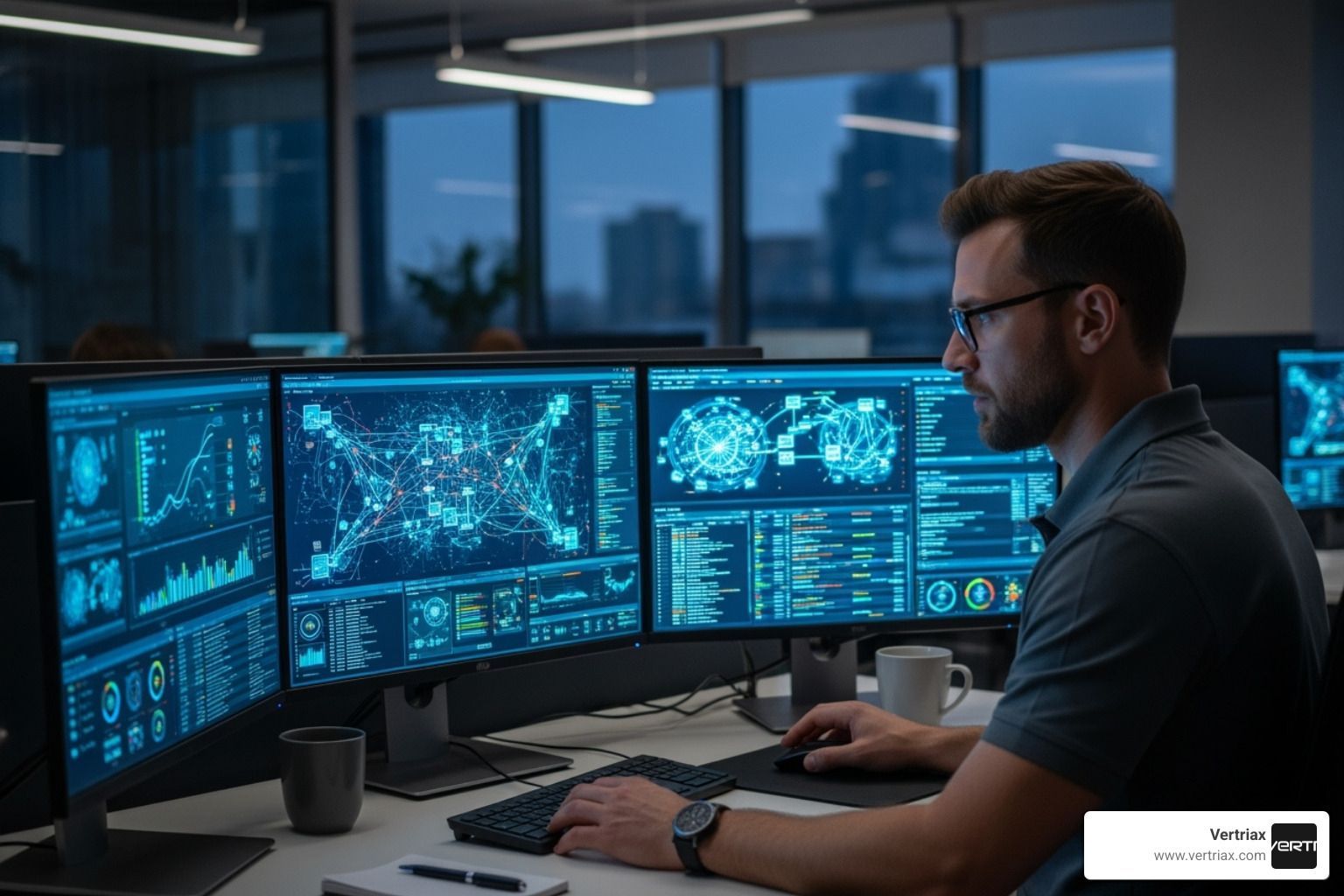Continuous Security Monitoring Made Simple (Even If You're Not a Tech Wizard)
What is Continuous Security Monitoring, Really?

Continuous security monitoring is the practice of constantly watching your organization's IT systems and networks to find cyber threats and security issues in real-time. Think of it as a home security system that never sleeps—it's always scanning for trouble and alerts you the moment something suspicious happens.
Quick Answer for Business Leaders:
- What it does : Provides 24/7 automated surveillance of your digital infrastructure.
- Why it matters : Detects threats before they become expensive breaches.
- Key benefit : Shifts you from reactive damage control to proactive threat prevention.
- Bottom line : Essential for protecting assets and maintaining business continuity.
Unlike traditional security audits that offer a snapshot in time, continuous monitoring provides ongoing, real-time visibility into your security posture. It automatically collects and analyzes data from network traffic, system logs, and user activity to spot anomalies that could signal an attack.
The goal is to catch problems before they become catastrophic data breaches that cost millions and destroy reputations. Modern cybersecurity can't start and stop; it must be an always-on operation.
I'm Stewart Smith, and with over 28 years leading security operations, I've seen how continuous security monitoring transforms an organization's ability to respond to threats. At Vertriax, we define it as maintaining ongoing awareness of information security, vulnerabilities, and threats to support organizational risk management. This means assessing security controls and risks with enough frequency to make timely, risk-based decisions to protect your information. It's a never-ending cycle of vigilance.
Why Your Business Can't Afford to Ignore It
Imagine cybercriminals quietly prowling your network at 3 AM. By the time you find the breach weeks later, they've stolen customer data and encrypted your files. This scenario plays out thousands of times daily across the globe.

The numbers tell a stark story. Cyber attacks surged by 30% in 2024 , and the average organization faces over 1,600 attacks per week. When these attacks succeed, the financial damage is devastating. The average cost of a data breach reached $4.45 million last year, jumping to $9.48 million for US businesses. Breached companies also tend to underperform by 15% over the next three years.
Major incidents like the Microsoft leak (250 million records) and the Keepnet Labs breach (5 billion records) show that even resourceful organizations are vulnerable. What's more troubling is that 81% of data breaches happen despite traditional security controls like firewalls and antivirus software being in place. Attackers often get in using simple stolen passwords.
The regulatory landscape adds another layer of complexity. Strict data protection laws like GDPR, CCPA, and HIPAA carry heavy penalties. The average cost of non-compliance is $14.82 million , potentially more than the breach itself. Many frameworks, including SOC2 and ISO 27001, now require continuous security monitoring to maintain certification, demanding ongoing vigilance beyond an annual audit.
At Vertriax, we've seen organizations transform their security by shifting to proactive threat hunting. Continuous security monitoring doesn't just meet compliance; it fundamentally changes how you protect your assets by actively watching for trouble. The question isn't if you can afford to implement it—it's whether you can afford not to.
To learn more about staying ahead of these evolving threats, explore our insights on Threat Monitoring Solutions 101: Catching Cyber Threats Before They Catch You.
The Nuts and Bolts of a Continuous Security Monitoring Program
At its heart, continuous security monitoring (or ISCM) is about maintaining constant vigilance over your digital assets. It provides real-time visibility into your security posture and ever-changing attack surface, allowing for informed, risk-based decisions based on what's happening now, not last month.
According to NIST Special Publication 800-137 , ISCM means "maintaining ongoing awareness of information security, vulnerabilities, and threats to support organizational risk management decisions." This moves organizations from compliance-driven to data-driven risk management. Our expertise in Security Operations ensures we implement these programs effectively. For details, see our Security Monitoring Services.
Key Components and Techniques
A successful continuous security monitoring program integrates several key techniques:
- Asset findy and management : You can't protect what you don't know you have. This involves continuously inventorying all digital assets, from apps and cloud storage to network devices.
- Vulnerability scanning : This is a regular health checkup for your digital infrastructure, identifying weaknesses and misconfigurations before attackers can exploit them.
- Log analysis : We act as digital detectives, analyzing logs from systems, apps, and devices to find clues about potential security events.
- Security Information and Event Management (SIEM) : This is the central command center that collects, correlates, and analyzes security data from your entire IT environment to detect complex threats.
- Threat intelligence feeds : These feeds provide up-to-date information on emerging threats, attack vectors, and indicators of compromise, helping us stay ahead of new dangers.
- User behavior analytics (UBA) : This monitors user activities for unusual behavior that could indicate an insider threat or a compromised account.
- Endpoint monitoring : We keep a close eye on all connected devices (laptops, servers, phones) using Endpoint Detection and Response (EDR) solutions to spot signs of compromise.
- Network traffic analysis : This examines data flow across your network to find anomalies, unauthorized access, and data exfiltration attempts.
- Configuration management : This ensures all systems maintain secure configurations and that changes adhere to security policies.
Combining these techniques gives us unparalleled visibility to respond swiftly to threats. To learn more, explore How 24/7 Monitoring Improves Threat Intelligence.
The Different Types of Monitoring
Continuous security monitoring isn't a one-size-fits-all approach; it's a layered defense strategy. We break it down into primary domains for comprehensive coverage.
| Monitoring Type | What it watches | Common threats detected | Example tools/methods |
|---|---|---|---|
| Infrastructure Monitoring | The health and performance of IT infrastructure (servers, networks, databases, OS). | Hardware failures, network outages, resource exhaustion, unauthorized access, malware. | System/network monitoring tools (e.g., Nagios), database monitoring, OS logs. |
| Application Monitoring | The performance and availability of software applications (web apps, mobile apps, APIs). | Application errors, performance bottlenecks, code vulnerabilities (SQL injection, XSS), abnormal user activity. | APM tools (e.g., Lightrun), user experience monitoring, code analysis tools (e.g., Spectral). |
| Network Monitoring | Network traffic, device connectivity, and communication patterns. | DDoS attacks, unauthorized network access, data exfiltration, port scanning, man-in-the-middle attacks. | Intrusion detection/prevention systems (IDS/IPS), network traffic analysis tools, firewalls. |
Each monitoring type is crucial. Infrastructure monitoring is the foundation, watching your IT backbone. Application monitoring focuses on the software your business relies on. Network monitoring acts as a digital border patrol, tracking data flow to catch serious threats like data theft. Integrated, they provide comprehensive protection.
The Power of Automation in Continuous Security Monitoring
Manually sifting through billions of daily security events is impossible. This is where automation, boosted by Artificial Intelligence (AI), revolutionizes security operations.
The numbers are compelling. Companies with fully deployed security AI and automation reduce data breach costs by over $1.7 million and identify breaches nearly 70% faster . This speed can mean the difference between a minor incident and a disaster.
Key benefits include:
- Reduced human error : Automated processes are consistent and tireless.
- 24/7 operation : Machines monitor your systems around the clock, providing real-time alerts.
- Improved visibility : Automation analyzes massive data volumes, with 71% of organizations reporting better security and compliance visibility.
- Increased efficiency : Automation streamlines repetitive tasks, freeing up security personnel for strategic work. 95% of organizations using it save time and resources.
- Proactive misconfiguration detection : Tools constantly scan for and remediate misconfigurations, a common vulnerability source.
While NIST notes that human expertise remains vital, automation is the indispensable engine for effective continuous security monitoring . Our approach at Vertriax blends cutting-edge automation with elite human experience. Learn more about our capabilities in Security Operations.
Building Your Fortress: A Step-by-Step Implementation Guide

Building a continuous security monitoring program is like constructing a fortress; it requires solid foundations and clear blueprints. At Vertriax, we guide organizations through this journey with strategic planning customized to their unique situation. This isn't a "one-size-fits-all" solution. Your risk tolerance and industry needs shape your program, which is why we integrate this with our Security Assessment and Systems Design services.
Continuous security monitoring is a living process that adapts with your organization. It requires ongoing attention to flourish.
6 Best Practices for a Successful CSM Program
Based on years of experience, we've identified six practices for a successful monitoring program.
- Define Clear Objectives : Before monitoring anything, identify your "crown jewels"—critical assets, data, and processes. Understand your regulatory requirements (HIPAA, GDPR, etc.). These goals will guide every decision.
- Establish a Baseline : You can't spot abnormal behavior if you don't know what's normal. Document typical network traffic, user activity, and system performance to create a reference point for detecting anomalies.
- Consolidate Your Tools : Avoid collecting too many disconnected tools. Focus on integration to create a unified view of your security posture. A well-configured SIEM can act as a central hub, reducing complexity and making your team more effective.
- Automate Everything Possible : Automation is a force multiplier. It handles the heavy lifting of data collection and analysis, runs vulnerability scans, and generates intelligent alerts, providing the 24/7 vigilance that modern threats demand.
- Develop an Incident Response Plan : Monitoring alerts are only useful if you have a plan. Define roles, communication flows, and steps for containing, investigating, and recovering from threats. A good plan prevents panic during a real incident.
- Review and Refine Continuously : The threat landscape is always changing. Regularly review your monitoring effectiveness, update configurations with new threat intelligence, and learn from past incidents. This iterative approach keeps your defenses strong.
This scalable approach works for any size business. The key is starting with a solid foundation and building systematically.
Frequently Asked Questions about Continuous Monitoring
We often encounter similar questions from business leaders about continuous security monitoring . Let's tackle some of the most common ones.
What's the difference between continuous monitoring and a one-time security audit?
This is a great question. Think of a one-time security audit as an annual health check-up—it gives you a snapshot of your security posture at a single moment. It's valuable, but it doesn't tell you what happens between visits.
Continuous security monitoring , on the other hand, is like a 24/7 fitness tracker for your IT environment. It's an ongoing, real-time process that catches changes and threats as they happen. This shifts you from a reactive approach (fixing problems found in an audit) to a proactive one where you detect and respond to issues immediately.
Is continuous monitoring only for large corporations?
Absolutely not. This is a common misconception. Threats don't discriminate by company size , and cybercriminals often view small and medium-sized businesses as easier targets.
The good news is that scalable continuous security monitoring solutions and managed services are now available for businesses of all sizes. You don't need a massive in-house security team to benefit. Furthermore, compliance requirements like HIPAA, PCI DSS, and GDPR apply to businesses regardless of size. From a cost perspective, proactive monitoring is far more effective than paying for a catastrophic breach. At Vertriax, we specialize in customized security services that scale to our clients' unique needs.
Does continuous monitoring guarantee we won't be breached?
No security measure can offer a 100% guarantee against all cyberattacks. Anyone who promises absolute security isn't being truthful, as the threat landscape is constantly evolving.
However, continuous security monitoring significantly reduces your risk and improves your ability to recover from attacks. Its key advantages are:
- Early threat detection : It allows you to identify suspicious activities much faster, often before they escalate into a full breach.
- Faster incident response : By pinpointing issues quickly, you can contain and remediate them efficiently, minimizing the impact and cost.
- Reduced attack surface : It constantly identifies and helps you close security gaps, giving attackers fewer opportunities.
While not a magic bullet, continuous security monitoring is arguably the most effective way to build a resilient security posture. It's about being proactive, and in cybersecurity, that makes all the difference.
Secure Your Future with Proactive Monitoring
The digital landscape has changed. Continuous security monitoring is the evolution from hoping for the best to knowing what's happening in your environment at all times. It's about taking control of your security destiny.
As we've seen, this approach transforms your security posture. You gain unparalleled visibility into threats, rapid detection that saves millions in breach costs, and improved compliance . You shift from reactive damage control to the confidence of proactive protection. With the average breach costing US businesses $9.48 million, the question isn't if you can afford continuous monitoring—it's if you can afford not to.
At Vertriax, we've perfected the art of continuous security monitoring . Our approach combines elite global experience with cutting-edge technology. We understand that every organization's risks are unique, so we don't offer one-size-fits-all solutions.
What sets us apart is our holistic approach . We integrate digital monitoring with physical security, executive protection, and overall risk management to ensure no blind spots and create a truly resilient security posture. Our team brings precision and operational excellence to every engagement, tailoring solutions for businesses of all sizes.
The future of security is proactive. To secure your organization, you need a partner who understands the full spectrum of modern challenges.
We invite you to explore our Comprehensive Advanced Security Solutions: A Holistic Approach to Protection and Operations to see how we integrate monitoring with broader security operations.
Ready to implement a robust security strategy? Explore our Security Monitoring Services and let us help you build your digital fortress—protection that works around the clock, so you can sleep better at night.



